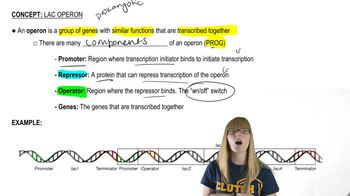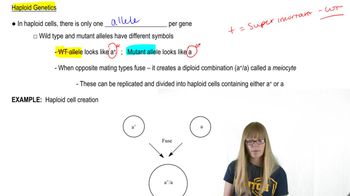Complete the accompanying table, indicating whether functionally active -galactosidase and permease are produced in the presence and absence of lactose. Use '+' to indicate the presence of a functional enzyme and '−' to indicate its absence. Indicate whether the partial diploid strain is lac⁺ (able to grow on lactose-only medium) or lac⁻ (cannot grow on lactose medium).
Table of contents
- 1. Introduction to Genetics51m
- 2. Mendel's Laws of Inheritance3h 37m
- 3. Extensions to Mendelian Inheritance2h 41m
- 4. Genetic Mapping and Linkage2h 28m
- 5. Genetics of Bacteria and Viruses1h 21m
- 6. Chromosomal Variation1h 48m
- 7. DNA and Chromosome Structure56m
- 8. DNA Replication1h 10m
- 9. Mitosis and Meiosis1h 34m
- 10. Transcription1h 0m
- 11. Translation58m
- 12. Gene Regulation in Prokaryotes1h 19m
- 13. Gene Regulation in Eukaryotes44m
- 14. Genetic Control of Development44m
- 15. Genomes and Genomics1h 50m
- 16. Transposable Elements47m
- 17. Mutation, Repair, and Recombination1h 6m
- 18. Molecular Genetic Tools19m
- 19. Cancer Genetics29m
- 20. Quantitative Genetics1h 26m
- 21. Population Genetics50m
- 22. Evolutionary Genetics29m
12. Gene Regulation in Prokaryotes
Lac Operon
Problem 19b
Textbook Question
List possible genotypes for lac operon haploids that have the following phenotypic characteristics:
The operon genes are never transcribed above a basal level, and the strain is unable to grow on a lactose medium. List two possible genotypes for this phenotype.
 Verified step by step guidance
Verified step by step guidance1
Understand the lac operon system: The lac operon in E. coli is a set of genes involved in lactose metabolism. It is regulated by the presence or absence of lactose and the activity of the repressor protein (lacI) and the operator region (lacO). The operon is transcribed when lactose is present and the repressor is inactive.
Analyze the phenotype: The operon genes are never transcribed above a basal level, meaning transcription is not induced even in the presence of lactose. Additionally, the strain cannot grow on a lactose medium, indicating that the enzymes required for lactose metabolism (e.g., β-galactosidase) are not produced.
Identify mutations that could cause this phenotype: A mutation in the lacI gene (e.g., lacI^s, a super-repressor mutation) could result in a repressor protein that cannot be inactivated by lactose, preventing transcription. Alternatively, a mutation in the lacO region (e.g., lacO^c, a constitutive operator mutation) could prevent the repressor from binding, but this does not match the phenotype described. Instead, a mutation in the promoter (P^−) could prevent RNA polymerase from binding, leading to no transcription.
List possible genotypes: One possible genotype is lacI^s P+ O+ Z+ Y+ A+, where the super-repressor mutation (lacI^s) prevents transcription regardless of lactose presence. Another possible genotype is lacI+ P− O+ Z+ Y+ A+, where the promoter mutation (P−) prevents RNA polymerase from initiating transcription.
Verify the genotypes against the phenotype: Both genotypes result in no transcription above basal levels and an inability to metabolize lactose, matching the described phenotype. These genotypes explain the observed characteristics of the strain.
 Verified video answer for a similar problem:
Verified video answer for a similar problem:This video solution was recommended by our tutors as helpful for the problem above
Video duration:
1mPlay a video:
Was this helpful?
Key Concepts
Here are the essential concepts you must grasp in order to answer the question correctly.
Lac Operon Structure
The lac operon is a set of genes in E. coli that are involved in the metabolism of lactose. It consists of three structural genes (lacZ, lacY, and lacA) and regulatory elements, including the promoter and operator. Understanding its structure is crucial for analyzing how mutations can affect gene expression and lactose utilization.
Recommended video:
Guided course

Lac Operon Overview
Gene Regulation
Gene regulation in the lac operon is primarily controlled by the presence or absence of lactose and glucose. When lactose is present, it binds to the repressor protein, allowing transcription of the operon. If the operon is never transcribed above a basal level, it indicates a mutation in the regulatory elements or the repressor, preventing lactose metabolism.
Recommended video:
Guided course

Review of Regulation
Haploidy and Genotype
Haploidy refers to organisms or cells that have a single set of chromosomes, such as certain bacterial strains. In the context of the lac operon, identifying genotypes involves understanding how specific mutations in the operon or its regulatory elements can lead to the inability to grow on lactose medium, which can be represented by different alleles affecting operon function.
Recommended video:
Guided course

Haploid Genetics
Related Videos
Related Practice
Textbook Question
993
views


